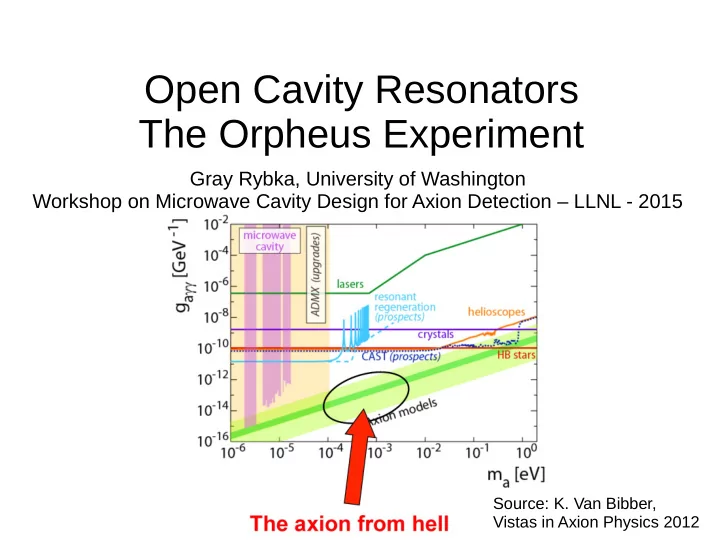

Open Cavity Resonators The Orpheus Experiment Gray Rybka, University of Washington Workshop on Microwave Cavity Design for Axion Detection – LLNL - 2015 Source: K. Van Bibber, Vistas in Axion Physics 2012
Beyond Current Axion Experiments Gen 2 ADMX Targets Reaching the highest masses is challenging: -Smaller Volumes -Lower Qs We have programs underway at UW (and elsewhere) to mitigate these challenges Workshop on Microwave Cavity Design for Axion Detection - LLNL 2015 - Gray Rybka 2
Axion Haloscope γ a γ Dark matter axions will convert to photons in a magnetic field. A high-Q cavity can enhance the conversion rate. See: Sikivie, Phys. Rev. Lett. 1983 To make an axion haloscope as sensitive as possible - You Want : You Don't Want: -Large Cavity Volume -High Thermal Noise -High Magnetic Field -High Amplifier Noise -High Cavity Q Workshop on Microwave Cavity Design for Axion Detection - LLNL 2015 - Gray Rybka 3
Power From Axion Conversion Axion-Photon Axion Resonator Coupling Frequency Quality 2 g γ ρ a f a B Q Vf − 21 W ( P = 1.5 × 10 7.6 T ) 0.97 0.45 GeV / cc 750 MHz 70,000 220 l Magnetic Dark Matter Field Density ( ∫ ⃗ 2 E ⋅⃗ Overlap of integral of BdV ) electric field of resonance 2 ∫ ⃗ E ⋅⃗ B E dV and magnetic fields Workshop on Microwave Cavity Design for Axion Detection - LLNL 2015 - Gray Rybka 4
Maximizing Power at High Frequencies Q decreases with increasing frequency, and volume decreases with wavelength in a constant magnetic field This mode couples to axions. This mode does not. (Form Factor 0.8) (Form Factor 0) Workshop on Microwave Cavity Design for Axion Detection - LLNL 2015 - Gray Rybka 5
“Orpheus” An experiment to look for higher-mass dark matter axions Built at operated primarily by undergraduates Ari Brill Kunal Patel Katleiah Ramos Robert Percival (Yale REU Student) UW UW UW Not Pictured: Gray Rybka, Andrew Wagner (postdoc) Workshop on Microwave Cavity Design for Axion Detection - LLNL 2015 - Gray Rybka 6
Key Concept: Spatially varying magnetic field matches E&M mode structure This is at optimal overlap Workshop on Microwave Cavity Design for Axion Detection - LLNL 2015 - Gray Rybka 7
Orpheus Design Workshop on Microwave Cavity Design for Axion Detection - LLNL 2015 - Gray Rybka 8
Open Resonator Prototype ADMX R&D: Orpheus Wire Plane Power Supply Amplification Reflector Reflector Network Analyzer Spectrum Analyzer (Measures Q) (Measures Power Out) Wire Planes Workshop on Microwave Cavity Design for Axion Detection - LLNL 2015 - Gray Rybka 9
Orpheus Data Analysis Axion Search Corrected Power Spectrum Raw Power Spectrum Workshop on Microwave Cavity Design for Axion Detection - LLNL 10/45 2015 - Gray Rybka
Orpheus Results Orpheus was operated for two weeks. Results published in Rybka et al. Phys. Rev. D 91, 011701(R) (2015) Simple benchtop sensitivity competitive with large-scale national lab laser experiments Many orders of magnitude improvement possible with improved B-Field, volume, Q, Mass Prediction* noise temperature *prediction from Visinelli et al. PRL 11, 011802 (2014) Workshop on Microwave Cavity Design for Axion Detection - LLNL 2015 - Gray Rybka 11
The Next Open Resonator Experiment ● Operate at liquid helium temperatures ● Operate at tesla scale fields ● Explore new axion-like particle couplings Support from Heising-Simons Foundation Workshop on Microwave Cavity Design for Axion Detection - LLNL 2015 - Gray Rybka 12
Design Change: Loaded Resonators Strategically placed dielectrics modify resonant mode electric field instead of changing magnetic field direction Conceptually similar to multiple wire planes, but easier to implement with high fields Longer wavelength Shorter wavelength in vacuum in dielectric Workshop on Microwave Cavity Design for Axion Detection - LLNL 2015 - Gray Rybka 13
Loaded Resonators: Implementation Using dielectric blocks placed periodically in a waveguide placed in a dipole field, TE Modes can couple to dark matter axions B To tune, blocks are moved inside Tuning mechanism prototype waveguide in a “breathing” motion Demonstrated here with waveguide, but we'll still use open resonators to reach maximum Q and volume Workshop on Microwave Cavity Design for Axion Detection - LLNL 2015 - Gray Rybka 14
Experiment Design Plate/reflector position In-house wound 1.5 T control rods superconducting coil fits into cryostat Alumina plates Reflectors Magnetic Field Direction Resonant mode electric field profile (estimated shape) (This is lowered into a LHe cryostat) Workshop on Microwave Cavity Design for Axion Detection - LLNL 2015 - Gray Rybka 15
Sensitivity Estimate We anticipate sensitivity to unexplored axion-like-particle couplings in a theoretically interesting mass range. This is over an order of magnitude better than the best limits so far. Previous Prototype Exclusion (best limit so far) Cryogenic Design Target Mass Prediction* *prediction from Visinelli et al. PRL 11, 011802 (2014) A more accurate prediction will be available once RF simulations are complete Workshop on Microwave Cavity Design for Axion Detection - LLNL 2015 - Gray Rybka 16
Next Steps ● RF Simulation & Engineering to start soon ● Fabrication early next year ● Assembly, testing, data taking in 2016 Workshop on Microwave Cavity Design for Axion Detection - LLNL 2015 - Gray Rybka 17
Far Future Current design target Potential Reach With -mK temperatures -2+ T fields -Qs of 10 5 or more -Larger Volumes Workshop on Microwave Cavity Design for Axion Detection - LLNL 2015 - Gray Rybka 18
Conclusions ● Benchtop open resonator prototype demonstrated technique is feasibly and powerful ● Cryogenic experiment being built to explore new ALP parameters and pave way for larger experiments ● This is a promising technique: ultimate sensitivity should be able to probe realistic axions up to 100 of μeV. Workshop on Microwave Cavity Design for Axion Detection - LLNL 2015 - Gray Rybka 19
Recommend
More recommend